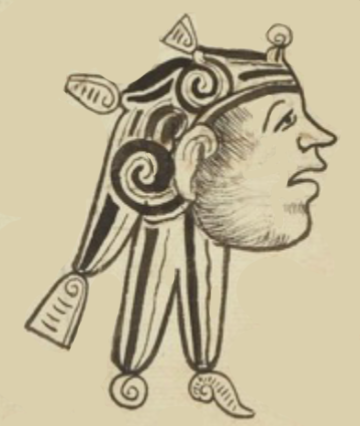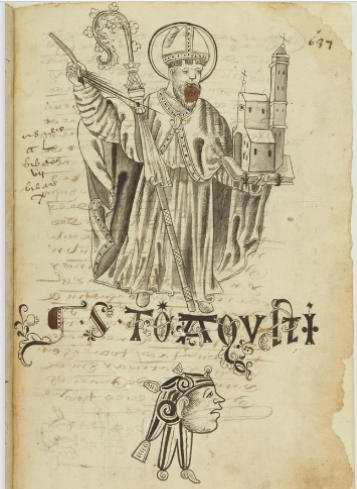Atzompa (MH637r)
Atzompa (MH637r)
This black-line drawing of the compound glyph for the place name Atzompa ("Moss" or "High Water Mark") shows a man's head (tzontli) in profile, looking toward the viewer's right. the man's nose and the side of his face are shaded, providing a three-dimensionality. In place of hair (also tzontli) on the man's head, there is water (atl). This water is exceptionally elaborate and detailed, including two swirls or whirlpools and three streams. At the end of each stream--and splashing off the top of his head--are a number of shells of varying size and shape, turbinates and caracoles. On some glyphs the tips of streams will have droplets that look like beads, but these streams are all finished off with shells. The swirls and streams all have both thick and thin lines of current (movement), reminiscent of the way water is shown in apantli glyphs.
Stephanie Wood
The contextualizing image for this glyph shows that this is a place called San Agustín Atzompa (in what is now the state of Puebla). The detail in the drawing of Saint Augustine is remarkable. The mitre and curling staff, the three-dimensional fabric of his robes, and the church he holds in his left hand are all superbly drawn, as though the artist was fascinated with it all and had had considerable Christian religious instruction.
Stephanie Wood
Stephanie Wood
agua, remolinos, cabezas, nombres de lugares, topónimos

Matrícula de Huexotzinco, folio 638r, World Digital Library, https://www.loc.gov/resource/gdcwdl.wdl_15282/?sp=356st=image.
This manuscript is hosted by the Library of Congress and the World Digital Library; used here with the Creative Commons, “Attribution-NonCommercial-ShareAlike 3.0 License” (CC-BY-NC-SAq 3.0).


